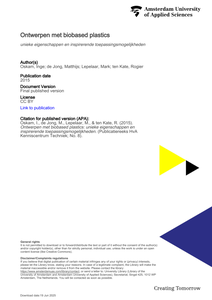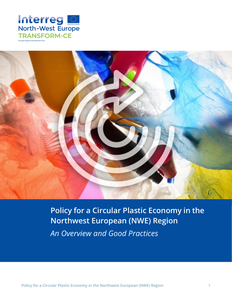‘Ontwerpen met biobased plastics’ is de eindpublicatie van het project “Design Challenges with Biobased Plastics”. In dit onderzoeksproject deed de HvA, samen met diverse mkb-bedrijven onderzoek naar de kennis een tools die ontwerpers nodig hebben om biobased plastics, kunststoffen van hernieuwbare materialen, toe te passen. De publicatie gaat in op de kansen die biobased plastics bieden en biedt praktische tools, inspirerende voorbeelden en handreikingen die het ontwerpen met deze materialen makkelijker maken.
DOCUMENT

Om de toepassing van biobased plastics te stimuleren is een belangrijke rol weggelegd voor ontwerpers. Omdat zowel gevestigdeontwerpers als studenten weinig tot geen kennis hebben van biobased plastics, doet de Hogeschool van Amsterdam (HvA) onderzoek naar verschillende aspecten van ontwerpen met biobased plastics.
MULTIFILE

DOCUMENT

In het project Circulaire Biopolymerenwaardeketens voor PHA en cellulose wil men naar afbreekbare en biogebaseerde plastics, producten en afzetmarkten toe. Kansloos als die nieuwe plastics moeten gaan concurreren met oliegebaseerde plastics die al in grote hoeveelheden worden geproduceerd; kansrijk als die plastics toegevoegde waarde bieden en het productieproces ervan een hoge theoretische en praktische opbrengst heeft.
LINK
In het dagelijks leven hebben we voortdurend met verschillende plastics te maken. Overal om ons heen komen we plastics tegen. Denk bijvoorbeeld aan verpakkingsmaterialen, flessen, flacons, kratten, tapijten en plastic draagtassen. Een leven zonder kunststoffen is in onze huidige maatschappij vrijwel ondenkbaar geworden. In 2014 werd er volgens Plastics Europe [1] wereldwijd maar liefst 311.000.000 ton aan kunststoffen geproduceerd, in 1950 was dit nog slechts 1.700.000 ton. Vanaf 1950 stijgt de wereldwijde productie van kunststoffen met gemiddeld 9% per jaar. Bij de huidige productiecapaciteit komt dit volgens Plastics Europe neer op gemiddeld 40 kg/jaar per hoofd van de wereldbevolking! Naar verwachting zal het gebruik van plastics verder toenemen naar gemiddeld 87 kg/jaar per hoofd van de wereldbevolking in het jaar 2050. In Nederland ligt het verbruik momenteel op gemiddeld 126 kg per inwoner. Maar volgens prognoses van VLEEM (Very Long Term Energy Environment Model) [2] zal dit groeien naar gemiddeld 220 kg per inwoner in 2050!! De toenemende vraag naar plastics wordt mede veroorzaakt omdat plastics op zich een gemakkelijk te verwerken materiaal is. Plastics zijn relatief goedkoop, hebben een lage specifieke dichtheid (t.o.v. bijvoorbeeld metalen), en zijn snel en gemakkelijk verwerkbaar.
DOCUMENT

Positioning paper bij de inauguratie van Vincent Voet als lector Circular Plastics.
DOCUMENT
![People. Planet. Polymer: een Wereld te Winnen [Inaugurele rede]](https://publinova-harvester-content-prod.s3.amazonaws.com/thumbnails/files/previews/pdf/20250506132442742072.Positioning20Paper20Vincent20Voet202024-thumbnail-400x300.png)
Plastic is one of the biggest contributors to pollution of the planet. Due to the low recyclability of oil-based plastics, most plastic is being disposed into the environment. According to plastic oceans, 10 million tons of plastic are dumped into oceans annually. Currently, researchers are developing recycling methods for oil-based plastics and are looking for biobased alternatives. One of these alternatives are a class of polymers called polyhydroxyalkanoates (PHA’s). PHA’s differ from other biobased polymers, due to the process of fabrication. PHA’s are a natural polymer, acting as an energy and carbon storage for different strains of bacteria. Functioning as an energy storage, nature can break down PHA’s and PHA-based waste. (1) Different companies are working on PHA’s production, but a large deviations in physical properties were observed. This research aims to establish a relationship between the chemical and physical properties of the different PHA’s, using gel permeability chromatography (GPC), nuclear magnetic resonance (NMR) and gas chromatography-mass spectroscopy (GC-MS).
DOCUMENT
Polyhydroxyalkanoates (PHAs) form a highly promising class of bioplastics for the transition from fossil fuel-based plastics to bio-renewable and biodegradable plastics. Mixed microbial consortia (MMC) are known to be able to produce PHAs from organic waste streams. Knowledge of key-microbes and their characteristics in PHA-producing consortia is necessary for further process optimization and direction towards synthesis of specific types of PHAs. In this study, a PHA-producing mixed microbial consortium (MMC) from an industrial pilot plant was characterized and further enriched on acetate in a laboratory-scale selector with a working volume of 5 L. 16S-rDNA microbiological population analysis of both the industrial pilot plant and the 5 L selector revealed that the most dominant species within the population is Thauera aminoaromatica MZ1T, a Gram-negative beta-proteobacterium belonging to the order of the Rhodocyclales. The relative abundance of this Thauera species increased from 24 to 40% after two months of enrichment in the selector-system, indicating a competitive advantage, possibly due to the storage of a reserve material such as PHA. First experiments with T. aminoaromatica MZ1T showed multiple intracellular granules when grown in pure culture on a growth medium with a C:N ratio of 10:1 and acetate as a carbon source. Nuclear magnetic resonance (NMR) analyses upon extraction of PHA from the pure culture confirmed polyhydroxybutyrate production by T. aminoaromatica MZ1T.
LINK
Polymeren, waaronder plastics, kennen we allemaal uit ons dagelijks leven. Van de plastic draagtas tot computeronderdelen en kopjes. Allemaal worden deze polymeren vervaardigd uit aardolie en afgeleide producten. De producten zijn zeer nuttig en breed toepasbaar, mede door de gunstige eigenschappen zoals warmteweerbaarheid, stevigheid en waterdichtheid. Daarentegen kennen polymeren ook een keerzijde, zoals het niet of moeilijk afbreekbaar zijn in de natuurlijke omgeving en de nadelen van het gebruik van fossiele bronnen: hun eindigheid en de ongecontroleerde emissie van broeikasgassen die verband houdt met klimaatverandering. Dit is een zichtbaar probleem bij onder meer De Plasticsoep, waar geen of beperkte afbraak plaatsvindt van plastics in de oceaan. De zoektocht naar alternatieven is daarom volop aan de gang.
DOCUMENT

This document combines four reports on existing regional business support programmes for inclusion or understanding of circular economy (CE) objectives, deliverable DT3.1.2 from the transform-CE project. Besides a general overview on national and regional level, the focus is on a selection of national and regional programmes aimed at the plastics industry. After explaining the format to structure the programmes, the results for the four regions are presented: Greater Manchester (UK), Rhineland Palatinate and North-Rhine Westphalia (DE), Wallonia (BE), Central Netherlands (NL).
MULTIFILE
